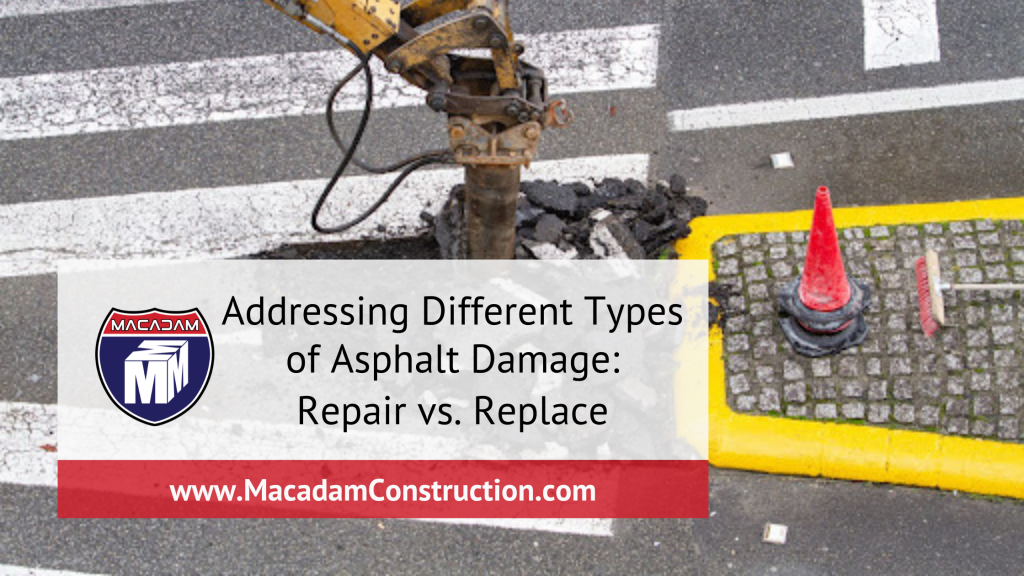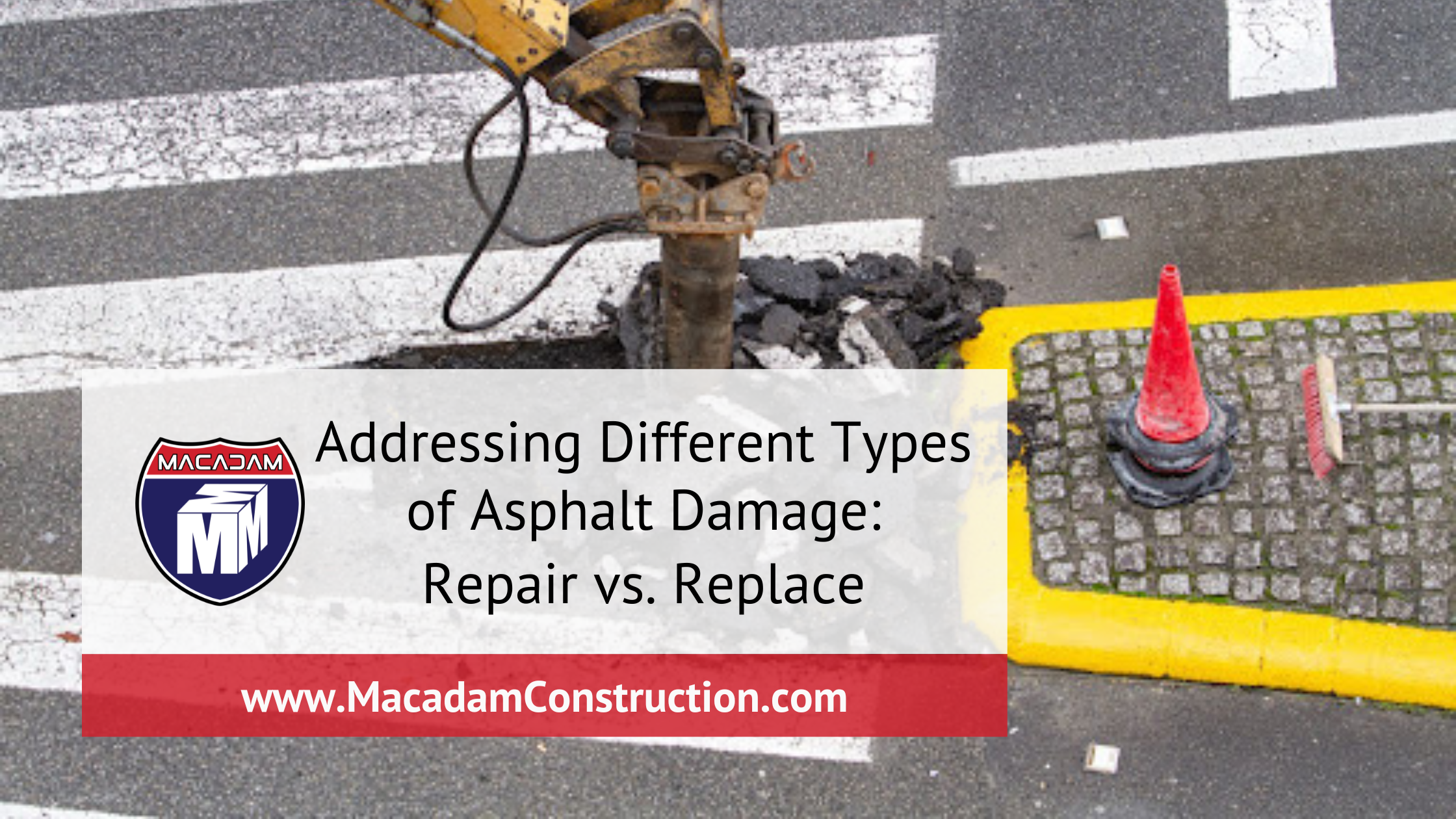
Maintaining the integrity of asphalt surfaces is crucial for ensuring safe and smooth transportation and enhancing the overall aesthetics of our roads, driveways, and parking lots. However, over time, asphalt can succumb to various types of damage, such as blacktop cracks, potholes, rutting, and fading, which can compromise its functionality and visual appeal. In this blog, we will delve into the topic of addressing different types of asphalt damage and explore the repair versus replace dilemma.
We will examine the common types of asphalt damage and the factors that contribute to their occurrence. Understanding the root causes of damage is essential in implementing effective repair and prevention strategies. We will also explore the repair techniques available for addressing various forms of damage, emphasizing the benefits of timely repairs in terms of cost-effectiveness and prolonging the lifespan of the pavement. Additionally, we will discuss the factors that influence the decision between repair and replacement, considering aspects such as the extent of damage, pavement condition, and long-term cost implications. By the end of this article, you will be equipped with the knowledge necessary to make informed decisions regarding the maintenance and restoration of asphalt surfaces.

Understanding Asphalt Damage
Asphalt damage can manifest in various forms, posing challenges that need to be addressed promptly. Cracks, potholes, rutting, and fading are some of the most common types of damage observed on asphalt surfaces. These issues can arise due to a combination of factors, including harsh weather conditions, heavy traffic loads, improper installation, and insufficient maintenance. By understanding the root causes of asphalt damage, we can develop effective strategies to mitigate further deterioration.
Detecting and addressing asphalt damage early on is crucial. Cracks, for example, can start small but quickly expand, allowing water and debris to penetrate the pavement and exacerbating the problem. Potholes pose safety hazards and can cause significant damage to vehicles. Rutting, the formation of grooves or depressions, can impair the smooth flow of traffic. Fading and discoloration not only detract from the appearance of the surface but also indicate potential underlying issues. By recognizing the signs of asphalt damage and taking timely action, we can minimize the extent of deterioration and prevent more extensive and costly repairs in the future.
Repairing Asphalt Damage
Addressing blacktop asphalt damage through timely repairs is crucial to maintain the structural integrity and functionality of the pavement. Various repair techniques are available to tackle different types of damage. For cracks, crack sealing is a common method that involves filling the fissures with specialized materials to prevent further spreading. Potholes, on the other hand, require patching techniques where the damaged area is removed and replaced with new asphalt or a suitable patching material. These repair methods not only restore the appearance of the pavement but also prevent water infiltration, which can lead to more severe damage.
One of the key advantages of repair is its cost-effectiveness compared to full pavement replacement. By addressing the damaged areas promptly, the overall deterioration can be halted, reducing the need for extensive reconstruction. Additionally, repairs help extend the lifespan of the pavement, ensuring its functionality for a longer duration. However, it is important to emphasize the significance of using high-quality materials and relying on professional contractors for asphalt paving and repair work. This ensures that the repairs are done correctly and with durable materials, providing long-lasting results.

Factors Influencing Repair vs. Replacement
When determining whether to opt for repair or replacement of damaged asphalt, several factors need to be considered. Firstly, assessing the extent and severity of the damage is crucial. Minor blacktop cracks or surface deterioration can often be effectively repaired, while extensive damage or structural issues may warrant a full replacement. Additionally, evaluating the age and overall condition of the pavement is essential. Older pavements that have undergone multiple repairs may be nearing the end of their lifespan, making replacement a more viable long-term solution.
Another important consideration is the long-term cost implications of repair versus replacement. While repairs may seem more cost-effective in the short term, repeatedly patching up a severely damaged pavement can accumulate significant expenses over time. In some cases, it may be more financially prudent to invest in a complete replacement that provides a fresh, durable surface and eliminates the need for frequent repairs. Moreover, environmental considerations and sustainability factors should be taken into account. Asphalt replacement can generate a substantial amount of waste, whereas targeted repairs can minimize environmental impact by reducing material consumption and waste generation.
Replacement of Damaged Asphalt
In certain situations, the replacement of damaged asphalt becomes necessary to restore the pavement to its optimal condition. There are indications that may warrant asphalt replacement, such as widespread and deep-seated cracks, extensive potholes, or severe structural damage that compromises the integrity of the pavement. Replacement involves removing the existing damaged asphalt and installing a new surface, providing a fresh start for a durable and functional pavement.
The process of asphalt replacement typically involves several steps. It begins with the assessment of the existing pavement and determining the scope of replacement required. The damaged asphalt is then removed using specialized equipment, and the underlying base is inspected and repaired if necessary. Finally, a new layer of asphalt is applied, compacted, and finished to create a smooth and resilient surface. While replacement offers the advantage of a completely renewed pavement, it is essential to carefully consider the cost, time, and disruption associated with the replacement process.

Conclusion
In conclusion, addressing different types of asphalt damage requires a proactive approach to ensure safe and visually appealing surfaces. By understanding the common types of damage and their causes, we can implement timely repairs to prevent further deterioration. Repair techniques tailored to specific damage, such as crack sealing and pothole patching, offer cost-effective solutions that extend the lifespan of the pavement. However, the decision between repair and replacement depends on factors such as the extent of damage, pavement condition, long-term cost implications, and environmental considerations.
At Macadam Construction, we specialize in blacktop asphalt repair and replacement services in Los Angeles, Orange County, and surrounding areas. With our expertise and dedication to quality, we can help you make informed decisions regarding the maintenance and restoration of your asphalt surfaces. Whether you require minor repairs or complete asphalt replacement, our professional team is ready to assist you. Visit our website or call us today to schedule a consultation and ensure the longevity and functionality of your asphalt surfaces.


